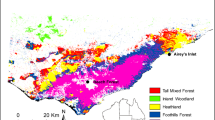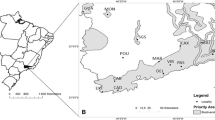Abstract
Species distribution models (SDMs) are increasingly used to predict environmentally induced range shifts of habitats of plant and animal species. Consequently SDMs are valuable tools for scientifically based conservation decisions. The aims of this paper are (1) to identify important drivers of butterfly species persistence or extinction, and (2) to analyse the responses of endangered butterfly species of dry grasslands and wetlands to likely future landscape changes in Switzerland. Future land use was represented by four scenarios describing: (1) ongoing land use changes as observed at the end of the last century; (2) a liberalisation of the agricultural markets; (3) a slightly lowered agricultural production; and (4) a strongly lowered agricultural production. Two model approaches have been applied. The first (logistic regression with principal components) explains what environmental variables have significant impact on species presence (and absence). The second (predictive SDM) is used to project species distribution under current and likely future land uses. The results of the explanatory analyses reveal that four principal components related to urbanisation, abandonment of open land and intensive agricultural practices as well as two climate parameters are primary drivers of species occurrence (decline). The scenario analyses show that lowered agricultural production is likely to favour dry grassland species due to an increase of non-intensively used land, open canopy forests, and overgrown areas. In the liberalisation scenario dry grassland species show a decrease in abundance due to a strong increase of forested patches. Wetland butterfly species would decrease under all four scenarios as their habitats become overgrown.




Similar content being viewed by others
References
Bailey SA, Haines-Young RH, Watkins C (2002) Species presence in fragmented landscapes: modelling of species requirements at the national level. Biol Conserv 108:307–316. doi:10.1016/S0006-3207(02)00119-2
Barbosa AM, Real R, Olivero J et al (2003) Otter (Lutra lutra) distribution modeling at two resolution scales suited to conservation planning in the Iberian Peninsula. Biol Conserv 114:377–387. doi:10.1016/S0006-3207(03)00066-1
Bätzing W (2003) Die Alpen. Geschichte und Zukunft einer europäischen Kulturlandschaft. Beck, München
BFS (1979/85) Arealstatistik. Bundesamt für Statistik Servicestelle GEOSTAT, Neuchâtel
BFS (1992/97) Arealstatistik. Bundesamt für Statistik, Servicestelle GEOSTAT, Neuchâtel
BFS (1997) Arealstatistik der Schweiz 1979/85 und Arealstatistik der Schweiz 1992/97, Neuchâtel
Bolliger J, Kienast F, Zimmermann NE (2000) Risks of global warming on montane and subalpine forests in Switzerland. Reg Environ Change 1:99–111. doi:10.1007/s101130000018
Bolliger J, Kienast F, Soliva R et al (2007) Spatial sensitivity of species habitat patterns to scenarios of land use change (Switzerland). Landsc Ecol 22:773–789. doi:10.1007/s10980-007-9077-7
Brennan LA, Kuvlesky WP (2005) North American grassland birds: an unfolding conservation crisis? J Wildl Manag 69:1–13. doi:10.2193/0022-541X(2005)069<0001:NAGBAU>2.0.CO;2
Chamberlain DE, Fuller RJ, Bunce RGH et al (2000) Changes in the abundance of farmland birds in relation to the timing of agricultural intensification in England and Wales. J Appl Ecol 37:771–788. doi:10.1046/j.1365-2664.2000.00548.x
Cohen J (1960) A coefficient of agreement for nominal scales. Educ Psychol Meas 20:37–46. doi:10.1177/001316446002000104
Crozier L (2003) Winter warming facilitates range expansion: cold tolerance of the butterfly Atalopedes campestris. Oecologia 135:648–656
Dirzo R, Raven PH (2003) Global state of biodiversity and loss. Annu Rev Environ Resour 28:137–167. doi:10.1146/annurev.energy.28.050302.105532
Dullinger S, Dirnböck T, Greimler J et al (2003) A resampling approach for evaluating effects of pasture abandonment on subalpine plant species diversity. J Veg Sci 14:243–252. doi:10.1658/1100-9233(2003)014[0243:ARAFEE]2.0.CO;2
Ebert G, Rennwald E (1993) Die Schmetterlinge Baden-Württembergs. Ulmer, Stuttgart
Eggenberg S, Dalang T, Dipner M et al (2001) Kartierung und Bewertung der Trockenwiesen und weiden von nationaler Bedeutung. Technischer Bericht. Schriftenreihe Umwelt Nr. 325. Bundesamt für Umwelt, Wald und Landschaft (BUWAL), Bern
Ehrlich PR, Ehrlich AH (1981) Extinction. The causes and consequences of the disappearance of species. Random House, New York
Engler R, Guisan A, Rechsteiner L (2004) An improved approach for predicting the distribution of rare and endangered species from occurrence and pseudo-absence data. J Appl Ecol 41:263–274. doi:10.1111/j.0021-8901.2004.00881.x
Erhardt A (1985) Wiesen und Brachland als Lebensraum für Schmetterlinge. Eine Feldstudie im Tavetsch (GR). Birkhäuser Verlag, Basel
Ewald KC (1978) Der Landschaftswandel: zur Veränderung schweizerischer Kulturlandschaften im 20. Jahrhundert. Eidgenössische Anstalt für das Forstliche Versuchswesen, Birmensdorf
Fielding AH, Bell JF (1997) A review of methods for the assessment of prediction errors in conservation presence/absence models. Environ Conserv 24:38–49. doi:10.1017/S0376892997000088
Glenz C, Massolo A, Kuonen D et al (2001) A wolf habitat suitability prediction study in Valais (Switzerland). Landsc Urban Plan 55:55–65. doi:10.1016/S0169-2046(01)00119-0
Gonseth Y (1987) Verbreitungsatlas der Tagfalter der Schweiz (Lepidoptera Rhopalocera). Documenta Faunistica Helvetiae. Centre Suisse de Carthographie de la Faune, Neuchâtel
Gonseth Y, Wohlgemuth T, Sansonnens B et al (2001) Die biogeographischen Regionen der Schweiz. Erläuterungen und Einteilungsstandard. Umwelt Materialien. Bundesamt für Umwelt Wald und Landschaft (BUWAL), Bern
Graham CH, Ferrier S, Huettman F et al (2004) New developments in museum-based informatics and applications in biodiversity analysis. Trends Ecol Evol 19:497–503. doi:10.1016/j.tree.2004.07.006
Guisan A, Hofer U (2003) Predicting reptile distributions at the mesoscale: relation to climate and topography. J Biogeogr 30:1233–1243. doi:10.1046/j.1365-2699.2003.00914.x
Guisan A, Thuiller W (2005) Predicting species distribution: offering more than simple habitat models? Ecol Lett 8:993–1009. doi:10.1111/j.1461-0248.2005.00792.x
Guisan A, Zimmermann NE (2000) Predictive habitat distribution models in ecology. Ecol Model 135:147–186. doi:10.1016/S0304-3800(00)00354-9
Guisan A, Theurillat JP, Kienast F (1998) Predicting the potential distribution of plant species in an Alpine environment. J Veg Sci 9:65–74. doi:10.2307/3237224
Guisan A, Edwards TC, Hastie T (2002) Generalized linear and generalized additive models in studies of species distributions: setting the scene. Ecol Model 157:89–100. doi:10.1016/S0304-3800(02)00204-1
Hosmer DW, Lemeshow S (2000) Applied logistic regression. Wiley, New York
Jaberg C, Guisan A (2001) Modelling the distribution of bats in relation to landscape structure in a temperate mountain environment. J Appl Ecol 38:1169–1181. doi:10.1046/j.0021-8901.2001.00668.x
Laiolo P, Dondero F, Ciliento E et al (2004) Consequences of pastoral abandonment for the structure and diversity of the alpine avifauna. J Appl Ecol 41:294–304. doi:10.1111/j.0021-8901.2004.00893.x
Leahy K (2000) Multicollinearity: when the solution is the problem. In: Rud OP (ed) Data mining cookbook: modeling data for marketing, risk and customer relationship management. Wiley, New York
Lepidopterologen-Arbeitsgruppe (2001) Tagfalter und ihre Lebensräume. Arten, Gefährdung, Schutz. Schweizerischer Bund für Naturschutz, Basel
Lindborg R, Cousins SAO, Eriksson O (2005) Plant species response to land use change—Campanula rotundifolia, Primula veris and Rhinanthus minor. Ecography 28:29–36. doi:10.1111/j.0906-7590.2005.03989.x
Lundström-Gilliéron C, Schlaepfer R (2003) Hare abundance as an indicator for urbanisation and intensification of agriculture in Western Europe. Ecol Model 168:283–301. doi:10.1016/S0304-3800(03)00142-X
Luoto M, Kuussaari M, Toivonen T (2002) Modelling butterfly distribution based on remote sensing data. J Biogeogr 29:1027–1037. doi:10.1046/j.1365-2699.2002.00728.x
Lütolf M, Kienast F, Guisan A (2006) The ghost of past species presences: improving species distribution models for presence-only data. J Appl Ecol 43:802–815. doi:10.1111/j.1365-2664.2006.01191.x
Manel S, Dias JM, Ormerod SJ (1999) Comparing discriminant analysis, neural networks and logistic regression for predicting species distributions: a case study with a Himalayan river bird. Ecol Model 120:337–347. doi:10.1016/S0304-3800(99)00113-1
Manel S, Williams HC, Ormerod SJ (2001) Evaluating presence-absence models in ecology: the need to account for prevalence. J Appl Ecol 38:921–931. doi:10.1046/j.1365-2664.2001.00647.x
Manly BFJ (1997) Randomization, bootstrap and Monte Carlo methods in biology. Chapman & Hall, London
McCullagh P, Nelder JA (1989) Generalized linear models. Chapman and Hall, London
Menzel A, Sparks TH, Estrella N et al (2006) Altered geographic and temporal variability in phenology in response to climate change. Glob Ecol Biogeogr 15:498–504
Monserud RA, Leemans R (1992) Comparing global vegetation maps with the Kappa-statistic. Ecol Model 62:275–293. doi:10.1016/0304-3800(92)90003-W
Mosteller F, Tukey J (1977) Data analysis and regression. Addison-Wesley, New York
Peterson AT, Robins CR (2003) Using ecological-niche modeling to predict Barred Owl invasions with implications for Spotted Owl conservation. Conserv Biol 17:1161–1165. doi:10.1046/j.1523-1739.2003.02206.x
Pfister C (ed) (1995) Das 1950er Syndrom: wege in die Konsumgesellschaft. Haupt, Bern
Rutherford G, Bebi P, Edwards PJ et al (2008) Assessing land-use statistics to model land cover change in a mountainous landscape in the European Alps. Ecol Model 212:460–471. doi:10.1016/j.ecolmodel.2007.10.050
Seifert B (1996) Ameisen: beobachten, bestimmen. Naturbuch-Verlag, Augsburg
Söderström B, Svensson B, Vessby K et al (2001) Plants, insects and birds in semi-natural pastures in relation to local habitat and landscape factors. Biodivers Conserv 10:1839–1863. doi:10.1023/A:1013153427422
Stefanescu C, Herrando S, Paramo F (2004) Butterfly species richness in the north-west Mediterranean Basin: the role of natural and human-induced factors. J Biogeogr 31:905–915. doi:10.1111/j.1365-2699.2004.01088.x
Suarez-Seoane S, Osborne PE, Baudry J (2002) Responses of birds of different biogeographic origins and habitat requirements to agricultural land abandonment in northern Spain. Biol Conserv 105:333–344. doi:10.1016/S0006-3207(01)00213-0
Tress B, Tress G (2003) Scenario visualisation for participatory landscape planning—a study from Denmark. Landsc Urban Plan 64:161–178. doi:10.1016/S0169-2046(02)00219-0
Vickery JA, Bradbury RB, Henderson IG et al (2004) The role of agri-environment schemes and farm management practices in reversing the decline of farmland birds in England. Biol Conserv 119:19–39. doi:10.1016/j.biocon.2003.06.004
Wilson EO (1988) Biodiversity. National Academy Press, Washington, DC
Zaniewski AE, Lehmann A, Overton JMC (2002) Predicting species spatial distributions using presence-only data: a case study of native New Zealand ferns. Ecol Model 157:261–280. doi:10.1016/S0304-3800(02)00199-0
Zimmermann NE, Kienast F (1999) Predictive mapping of alpine grasslands in Switzerland: species versus community approach. J Veg Sci 10:469–482. doi:10.2307/3237182
Acknowledgments
This study was supported by a grant from the Swiss National Science Foundation (application No 4048-064460) in the program “Landscapes and Habitats of the Alps” (NRP 48). We are thankful to Gillian Rutherford for providing the data on the transition probabilities and Nick Zimmermann for providing the climatic maps. Several colleagues and an anonymous reviewer provided constructive comments and helped to improve the quality of the manuscript.
Author information
Authors and Affiliations
Corresponding author
Rights and permissions
About this article
Cite this article
Lütolf, M., Bolliger, J., Kienast, F. et al. Scenario-based assessment of future land use change on butterfly species distributions. Biodivers Conserv 18, 1329–1347 (2009). https://doi.org/10.1007/s10531-008-9541-y
Received:
Accepted:
Published:
Issue Date:
DOI: https://doi.org/10.1007/s10531-008-9541-y




